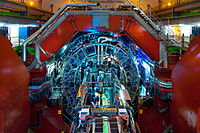
Photo from wikipedia
It has been proposed that strong electromagnetic fields produced in the early stages of heavy-ion collisions can lead to splitting of the rapidity-odd directed flow of positive and negative hadrons.… Click to show full abstract
It has been proposed that strong electromagnetic fields produced in the early stages of heavy-ion collisions can lead to splitting of the rapidity-odd directed flow of positive and negative hadrons. For light hadrons, the interpretation of such measurements is complicated by the low magnitude of directed flow as well as by ambiguities arising from transported quarks. To overcome these complications, we propose measurements using only hadrons carrying produced quarks (ū, d̄, s, s̄). We discuss how to identify the kinematics where such hadrons are produced via the coalescence mechanism and therefore their flow is the sum of the flow of their constituent quarks. With this sum rule verified for certain combinations of hadrons, the expected systematic violation of this rule with increasing electric charge can be measured, which could be a consequence of the electromagnetic fields produced in the collisions. Our approach can be tested with the high statistics data from Phase II of the Beam Energy Scan (BES) program at the Relativistic Heavy Ion Collider (RHIC).
Journal Title: Physical Review C
Year Published: 2022
Link to full text (if available)
Share on Social Media: Sign Up to like & get
recommendations!